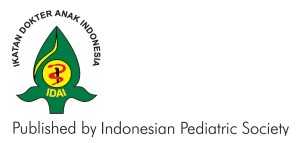Tuberculosis risk factors in children with smear-positive tuberculosis adult as household contact
Abstract
Background Children in household contact of adults with smear-positive tuberculosis (TB) are at higher risk of TB infection. Screening of these children is a main strategy for eliminating childhood TB.
Objective To determine risk factors of TB among children in household contact with smear-positive adult TB patients.
Methods This case-control study was conducted in 5 public health centers at Batu Bara District, North Sumatera. We studied children from birth to 18 year-old living in the same house as adults with smear-positive TB. A tuberculosis scoring system was used to diagnosis TB in the children. Associations between risk factors and the incidence of TB were analyzed using Chi-square, Mann-Whitney U, and logistic regression tests.
Results We enrolled 145 children who had household contact with smear-positive adult TB patients. Subjects were allocated to either the case group [TB score >6; 61 subjects (42.0%)] or the control group [TB score <6; 84 subjects (58.0%)]. Bivariate analysis revealed that nutritional status, immunization status, number of people in the house, sleeping in the same bed, and duration of household contact had significant associations with the incidence of TB. By multivariate logistic regression analysis, nutritional status and duration of household contact were significant risk factors for TB, with OR 5.89 and 8.91, respectively.
Conclusion Malnutrition and duration of household contact with smear-positive adult TB patients of more than 6 hours per day were risk factors for TB among children.
References
Singh J, Sankar MM, Kumar S, Gopinath K, Singh N, Mani K, et al. Incidence and prevalence of tuberculosis among household contacts of pulmonary tuberculosis patients in a peri-urban population of South Delhi, India. Plos One. 2013;8:e69730.
Hu Y, Zhao Q, Wu L, Wang W, Yuan Z, Xu B. Prevalence of latent tuberculosis infection and its risk factors in schoolchildren and adolescents in Shanghai, China. Eur J Public Health. 2013;23:1064-9.
Kartasasmita CB, Basir D. Epidemiology. In: Rahajoe NN, Supriyatno B, Setyanto DB, editors. Buku ajar respirologi anak. 1st ed. Jakarta: Ikatan Dokter Anak Indonesia; 2008. p. 162-7.
Rahajoe NN, Makmuri MS. Tatalaksana tuberkulosis pada saran terbatas In: Rahajoe NN, Supriyatno B, Setyanto DB, editors. Buku ajar respirologi anak. 1st ed. Jakarta: Ikatan Dokter Anak Indonesia; 2008. p. 246-51.
Lestari P, Sustini F, Endaryanto A, Asih R. Home humidity increased risk of tuberculosis in children living with adult active tuberculosis cases. Univ Med. 2011;30:138-45.
Rutherford ME, Hill PC, Maharani W, Apriani L, Sampurno H, van Crevel R, et al. Risk factors for Mycobacterium tuberculosis infection in Indonesian children living with a sputum smear-postive case. Int J Tuberc Lung Dis. 2012;16:1594-9.
Loredo C, Cailleaux-Cezar M, Efron A, de Mello FC, Conde MB. Yield of close contact tracing using two different programmatic approaches from tuberculosis index cases: a retrospective quasi-experimental study. BMC Pulm Med. 2014;14:133.
Jia Z, Cheng S, Ma Y, Zhang T, Bai L, Xu W, et al. Tuberculosis burden in China: a high prevalence of pulmonary tuberculosis in household contacts with and without symptom. BMC Infect Dis. 2014;14:64.
Stevens H, Ximenes RAA, Dantas OMS, Rodrigues LC. Risk factors for tuberculosis in older children and adolescents: a matched case-control study in recife, Brazil. Emerg Them Epid. 2014;11(20):1-7
Mandal P, Craxton R, Chalmers JD, Gilhooley S, Laurenson IF, McSparron C, et al. Contact tracing in pulmonary and non-pulmonary tuberculosis. QJM. 2012;105:741-7.
Lonnroth K, Corbett E, Golub J, Godfrey-Faussett P, Uplekar M, Well D, et al. Systematic screening for active tuberculosis: rationale, definitions and key considerations. Int J Tuberc Lung Dis. 2013;17:289-98.
Lohmann EM, Koster BF, le Cessie S, Kamst-van Agterverd MP, van Soolingen D, Arend SM. Grading of a positive sputum smear and the risk of Mycobacterium tuberculosis transmission. Int J Tuberc Lung Dis. 2012;16:1477-84.
Rahajoe NN, Basir D, Makmuri MS, Kartasasmita CB. Pedoman nasional tuberkulosis anak. Jakarta: Unit Kerja Koordinasi Pengurus Pusat Ikatan Dokter Anak Indonesia. 2008.
Jaganath D, Mupere E. Childhood tuberculosis and malnutrition. J Infect Dis. 2012;206:1809-15.
Karim MR, Rahman MA, Mamun SAA, Alam MA, Akhter S. Risk factors of childhood tuberculosis: a case control study from rural Bangladesh. WHO South East J Public Health. 2012;1:76-84.
Authors who publish with this journal agree to the following terms:
Authors retain copyright and grant the journal right of first publication with the work simultaneously licensed under a Creative Commons Attribution License that allows others to share the work with an acknowledgement of the work's authorship and initial publication in this journal.
Authors are able to enter into separate, additional contractual arrangements for the non-exclusive distribution of the journal's published version of the work (e.g., post it to an institutional repository or publish it in a book), with an acknowledgement of its initial publication in this journal.

This work is licensed under a Creative Commons Attribution-NonCommercial-ShareAlike 4.0 International License.
Accepted 2018-04-16
Published 2018-04-30












